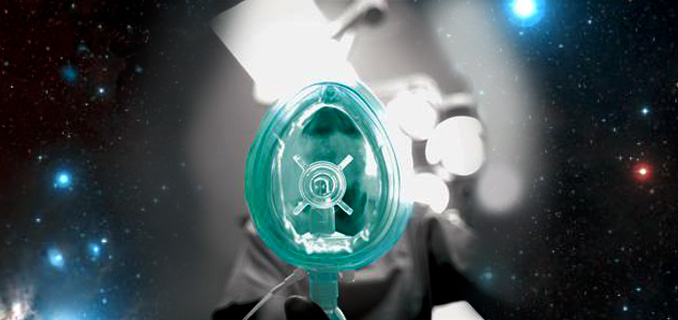Banishing consciousness: the mystery of anaesthesia
Source: newscientist.com

I walk into the operating theatre feeling vulnerable in a draughty gown and surgical stockings. Two anaesthetists in green scrubs tell me to stash my belongings under the trolley and lie down. "Can we get you something to drink from the bar?" they joke, as one deftly slides a needle into my left hand.
I smile weakly and ask for a gin and tonic. None appears, of course, but I begin to feel light-headed, as if I really had just knocked back a stiff drink. I glance at the clock, which reads 10.10 am, and notice my hand is feeling cold. Then, nothing.
I have had two operations under general anaesthetic this year. On both occasions I awoke with no memory of what had passed between the feeling of mild wooziness and waking up in a different room. Both times I was told that the anaesthetic would make me feel drowsy, I would go to sleep, and when I woke up it would all be over.
What they didn’t tell me was how the drugs would send me into the realms of oblivion. They couldn’t. The truth is, no one knows.
The development of general anaesthesia has transformed surgery from a horrific ordeal into a gentle slumber. It is one of the commonest medical procedures in the world, yet we still don’t know how the drugs work. Perhaps this isn’t surprising: we still don’t understand consciousness, so how can we comprehend its disappearance?
That is starting to change, however, with the development of new techniques for imaging the brain or recording its electrical activity during anaesthesia. "In the past five years there has been an explosion of studies, both in terms of consciousness, but also how anaesthetics might interrupt consciousness and what they teach us about it," says George Mashour, an anaesthetist at the University of Michigan in Ann Arbor. "We’re at the dawn of a golden era."
Consciousness has long been one of the great mysteries of life, the universe and everything. It is something experienced by every one of us, yet we cannot even agree on how to define it. How does the small sac of jelly that is our brain take raw data about the world and transform it into the wondrous sensation of being alive? Even our increasingly sophisticated technology for peering inside the brain has, disappointingly, failed to reveal a structure that could be the seat of consciousness.
Altered consciousness doesn’t only happen under a general anaesthetic of course - it occurs whenever we drop off to sleep, or if we are unlucky enough to be whacked on the head. But anaesthetics do allow neuroscientists to manipulate our consciousness safely, reversibly and with exquisite precision.
It was a Japanese surgeon who performed the first known surgery under anaesthetic, in 1804, using a mixture of potent herbs. In the west, the first operation under general anaesthetic took place at Massachusetts General Hospital in 1846. A flask of sulphuric ether was held close to the patient’s face until he fell unconscious.
Since then a slew of chemicals have been co-opted to serve as anaesthetics, some inhaled, like ether, and some injected. The people who gained expertise in administering these agents developed into their own medical specialty. Although long overshadowed by the surgeons who patch you up, the humble "gas man" does just as important a job, holding you in the twilight between life and death.
Consciousness may often be thought of as an all-or-nothing quality - either you’re awake or you’re not - but as I experienced, there are different levels of anaesthesia (see diagram). "The process of going into and out of general anaesthesia isn’t like flipping a light switch," says Mashour. "It’s more akin to a dimmer switch."
A typical subject first experiences a state similar to drunkenness, which they may or may not be able to recall later, before falling unconscious, which is usually defined as failing to move in response to commands. As they progress deeper into the twilight zone, they now fail to respond to even the penetration of a scalpel - which is the point of the exercise, after all - and at the deepest levels may need artificial help with breathing.
These days anaesthesia is usually started off with injection of a drug called propofol, which gives a rapid and smooth transition to unconsciousness, as happened with me. (This is also what Michael Jackson was allegedly using as a sleeping aid, with such unfortunate consequences.) Unless the operation is only meant to take a few minutes, an inhaled anaesthetic, such as isoflurane, is then usually added to give better minute-by-minute control of the depth of anaesthesia.
Lock and key
So what do we know about how anaesthetics work? Since they were first discovered, one of the big mysteries has been how the members of such a diverse group of chemicals can all result in the loss of consciousness. Other drugs work by binding to receptor molecules in the body, usually proteins, in a way that relies on the drug and receptor fitting snugly together like a key in a lock. Yet the long list of anaesthetic agents ranges from large complex molecules such as barbiturates or steroids, to the inert gas xenon, which exists as mere atoms. How could they all fit the same lock?
[...]
Read the full article at: newscientist.com
Tune into Red Ice Radio:
Sonia Barrett & Sharry Edwards - Hour 1 - The Business of Disease
Tom Campbell - The Big TOE (Theory of Everything), Consciousness & Reality
Anthony Peake & Tom Campbell - Consciousness Creates Reality
Anthony Peake - Mystery of the Brain, Precognition, Time Dilation & Déjà vu
Peter Russell - The Primacy of Consciousness
Scott Onstott - Hour 1 - Explorations in Number, Architecture & Consciousness
Jim Elvidge - Are we Living in a Simulation, a Programmed Reality?
Paul Levy - The War on Consciousness
Marcel Kuijsten - Julian Jaynes, the Bicameral Mind & The Origin of Consciousness
Graham Hancock - Entangled, Supernatural, Shamanism & The Origins of Consciousness






















